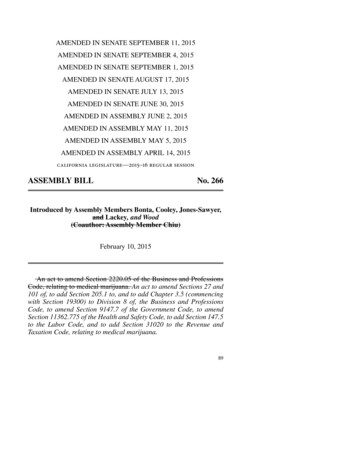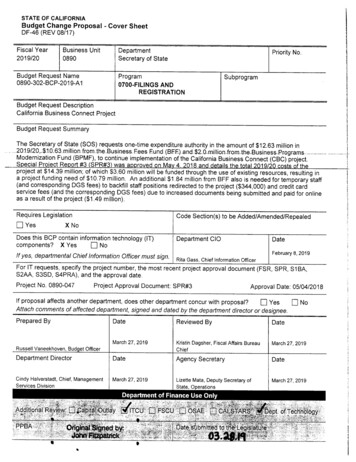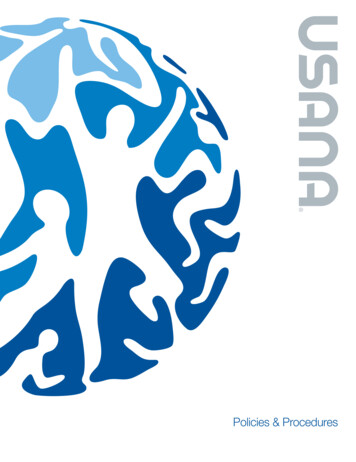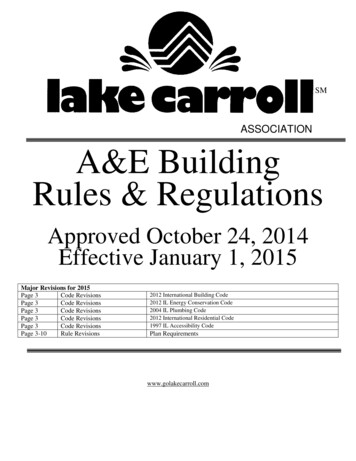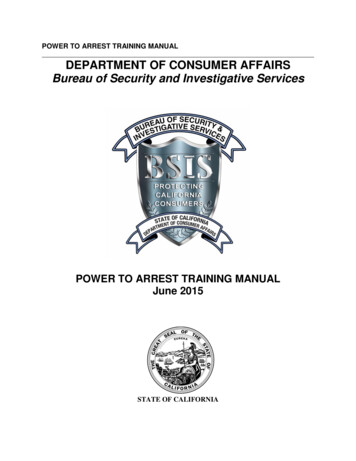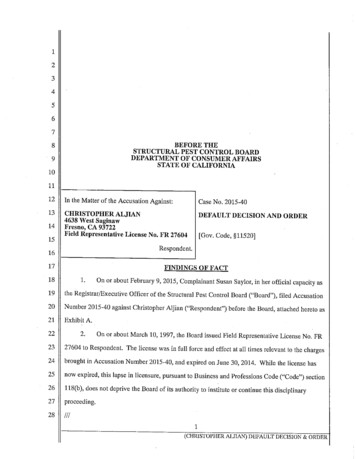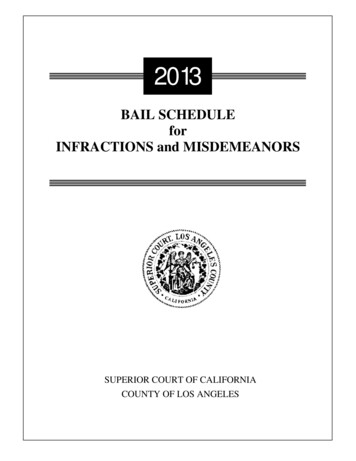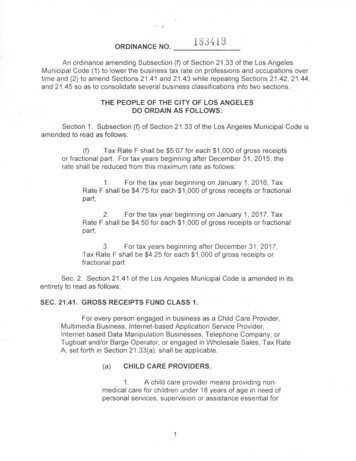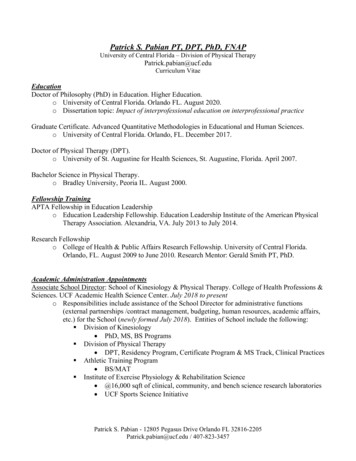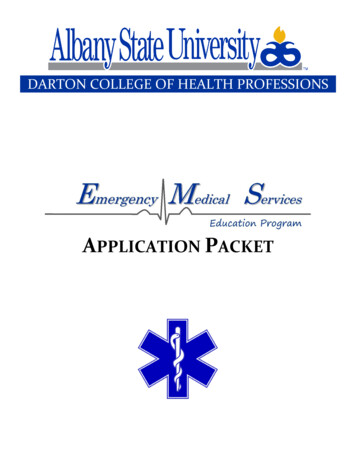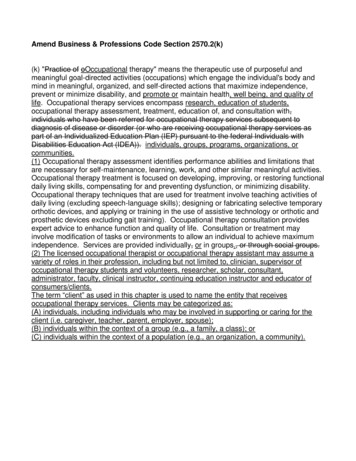
Transcription
Amend Business & Professions Code Section 2570.2(k)(k) "Practice of oOccupational therapy" means the therapeutic use of purposeful andmeaningful goal-directed activities (occupations) which engage the individual's body andmind in meaningful, organized, and self-directed actions that maximize independence,prevent or minimize disability, and promote or maintain health, well being, and quality oflife. Occupational therapy services encompass research, education of students,occupational therapy assessment, treatment, education of, and consultation with,individuals who have been referred for occupational therapy services subsequent todiagnosis of disease or disorder (or who are receiving occupational therapy services aspart of an Individualized Education Plan (IEP) pursuant to the federal Individuals withDisabilities Education Act (IDEA)). individuals, groups, programs, organizations, orcommunities.(1) Occupational therapy assessment identifies performance abilities and limitations thatare necessary for self-maintenance, learning, work, and other similar meaningful activities.Occupational therapy treatment is focused on developing, improving, or restoring functionaldaily living skills, compensating for and preventing dysfunction, or minimizing disability.Occupational therapy techniques that are used for treatment involve teaching activities ofdaily living (excluding speech-language skills); designing or fabricating selective temporaryorthotic devices, and applying or training in the use of assistive technology or orthotic andprosthetic devices excluding gait training). Occupational therapy consultation providesexpert advice to enhance function and quality of life. Consultation or treatment mayinvolve modification of tasks or environments to allow an individual to achieve maximumindependence. Services are provided individually, or in groups., or through social groups.(2) The licensed occupational therapist or occupational therapy assistant may assume avariety of roles in their profession, including but not limited to, clinician, supervisor ofoccupational therapy students and volunteers, researcher, scholar, consultant,administrator, faculty, clinical instructor, continuing education instructor and educator ofconsumers/clients.The term “client” as used in this chapter is used to name the entity that receivesoccupational therapy services. Clients may be categorized as:(A) individuals, including individuals who may be involved in supporting or caring for theclient (i.e. caregiver, teacher, parent, employer, spouse);(B) individuals within the context of a group (e.g., a family, a class); or(C) individuals within the context of a population (e.g., an organization, a community).
Proposed Amendment to Business & Professions Code 2570.2(k)"Practice of eOccupational therapy" means the therapeutic use of purposeful andmeaningful goal-directed activities (occupations) which engage the individual's body andmind in meaningful, organized, and self-directed actions that maximize independence,prevent or minimize disability, and promote or maintain health, well-being, and quality oflife. Occupational therapy services encompass research, occupational therapyassessment, treatment, education of, andconsultation with, individuals who have beenreferred for occupational therapy services subsequent to diagnosis of disease or disorder(or who are receiving occupational therapy services as part of an Individualized EducationPlan (IEP) pursuant to the federal Individuals with Disabilities Education Act (I DEL'.)).individuals, groups, programs, organizations, or communities.ill Occupational therapy assessment identifies performance abilities and limitations thatare necessary for self-maintenance, learning, work, and other similar meaningful activities.Occupational therapy treatment is focused on developing, improving, or restoring functionaldaily living skills, compensating for and preventing dysfunction, or minimizing disability.Occupational therapy techniques that are used for treatment involve teaching activities ofdaily living (excluding speech-language skills); designing or fabricating selective temporaryorthotic devices, and applying or training in the use of assistive technology or orthotic andprosthetic devices (excluding gait training). Occupational therapy consultation providesexpert advice to enhance function and quality of life. Consultation or treatment mayinvolve modification of tasks or environments to allow an individual to achieve maximumindependence. Services are provided individually, in groups, or through social groups.(2) The licensed occupational therapist or occupational therapy assistant may assume avariety of roles, including but not limited to, practitioner, supervisor of professional studentsand volunteers, researcher, scholar, consultant, administrator, faculty, clinical instructor,and educator of consumers, peers, and family.
Definition of Occupational Therapy Practice for the AOTA Model Practice ActThe practice of occupational therapy means the therapeutic use of occupations, including everyday life activities withindividuals, groups, populations, or organizations to support participation, performance, and function in roles andsituations in home, school, workplace, community, and other settings. Occupational therapy services are provided forhabilitation, rehabilitation, and the promotion of health and wellness to those who have or are at risk for developingan illness, injury, disease, disorder, condition, impairment, disability, activity limitation, or participation restriction.Occupational therapy addresses the physical, cognitive, psychosocial, sensory-perceptual, and other aspects ofperformance in a variety of contexts and environments to support engagement in occupations that affect physical andmental health, well-being, and quality of life.The practice of occupational therapy includes:A. Evaluation of factors affecting activities of daily living (ADL), instrumental activities of daily living(IADL), rest and sleep, education, work, play, leisure, and social participation, including:1. Client factors, including body functions (such as neuromusculoskeletal, sensory-perceptual, visual,mental, cognitive, and pain factors) and body structures (such as cardiovascular, digestive,nervous, integumentary, genitourinary systems, and structures related to movement), values,beliefs, and spirituality.2. Habits, routines, roles, rituals, and behavior patterns.3. Physical and social environments, cultural, personal, temporal, and virtual contexts and activitydemands that affect performance.4. Performance skills, including motor and praxis, sensory-perceptual, emotional regulation,cognitive, communication and social skills.B. Methods or approaches selected to direct the process of interventions such as:1. Establishment, remediation, or restoration of a skill or ability that has not yet developed, isimpaired, or is in decline.2. Compensation, modification, or adaptation of activity or environment to enhance performance, orto prevent injuries, disorders, or other conditions.3. Retention and enhancement of skills or abilities without which performance in everyday lifeactivities would decline.4. Promotion of health and wellness, including the use of self-management strategies, to enable orenhance performance in everyday life activities.5. Prevention of barriers to performance and participation, including injury and disability prevention.C. Interventions and procedures to promote or enhance safety and performance in activities of daily living(ADL), instrumental activities of daily living (IADL), rest and sleep, education, work, play, leisure, andsocial participation, including:1. Therapeutic use of occupations, exercises, and activities.2. Training in self-care, self-management, health management and maintenance, home management,community/work reintegration, and school activities and work performance.3. Development, remediation, or compensation of neuromusculoskeletal, sensory-perceptual, visual,mental, and cognitive functions, pain tolerance and management, and behavioral skills.4. Therapeutic use of self, including one’s personality, insights, perceptions, and judgments, as partof the therapeutic process.5. Education and training of individuals, including family members, caregivers, groups, populations,and others.6. Care coordination, case management, and transition services.7. Consultative services to groups, programs, organizations, or communities.8. Modification of environments (home, work, school, or community) and adaptation of processes,including the application of ergonomic principles.9. Assessment, design, fabrication, application, fitting, and training in seating and positioning,assistive technology, adaptive devices, and orthotic devices, and training in the use of prostheticdevices.10. Assessment, recommendation, and training in techniques to enhance functional mobility, includingmanagement of wheelchairs and other mobility devices.11. Low vision rehabilitation.
12. Driver rehabilitation and community mobility.13. Management of feeding, eating, and swallowing to enable eating and feeding performance.14. Application of physical agent modalities, and use of a range of specific therapeutic procedures(such as wound care management; interventions to enhance sensory-perceptual, and cognitiveprocessing; and manual therapy) to enhance performance skills.15. Facilitating the occupational performance of groups, populations, or organizations through themodification of environments and the adaptation of processes.Adopted by the Representative Assembly 4/14/11 (Agenda A13, Charge 18)
Scope of PracticeStatement of PurposeThe purpose of this document is toA. Define the scope of practice in occupational therapy by1.Delineating the domain of occupational therapy practice and services provided by occupationaltherapists and occupational therapy assistants;2.Delineating the dynamic process of occupational therapy evaluation and intervention servicesused to achieve outcomes that support the participation of clients in everyday life activities(occupations); and3.Describing the education and certification requirements needed to practice as an occupationaltherapist and occupational therapy assistant;B. Inform consumers, health care providers, educators, the community, funding agencies, payers,referral sources, and policymakers regarding the scope of occupational therapy.IntroductionThe occupational therapy scope of practice is based on the American Occupational Therapy Association(AOTA) documents Occupational Therapy Practice Framework: Domain and Process (AOTA, 2014b) and Phil-osophical Base of Occupational Therapy (AOTA, 2011b), which states that “the use of occupation to promoteindividual, community, and population health is the core of occupational therapy practice, education,research, and advocacy” (p. S65). Occupational therapy is a dynamic and evolving profession that isresponsive to consumer and societal needs, to system changes, and to emerging knowledge and research.This document is designed to support and be used in conjunction with the Definition of Occupational Therapy Practice for the AOTA Model Practice Act (AOTA, 2011a). Although this document may be a resource toaugment state statutes and regulations that govern the practice of occupational therapy, it does not supersede existing laws and other regulatory requirements. Occupational therapists and occupational therapyassistants are required to abide by relevant statutes and regulations when providing occupational therapyservices. State statutes and other regulatory requirements typically include statements about educationalrequirements to practice occupational therapy, procedures to practice occupational therapy legally withinthe defined area of jurisdiction, the definition and scope of occupational therapy practice, and supervisionrequirements for occupational therapy assistants.It is the position of AOTA that a referral is not required for the provision of occupational therapy services,but referrals for such services are generally affected by laws and payment policy. AOTA’s position is alsothat “an occupational therapist accepts and responds to referrals in compliance with state or federal laws,other regulatory and payer requirements, and AOTA documents” (AOTA 2010b, Standard I1.2, p. S108).State laws and other regulatory requirements should be viewed as minimum criteria to practice occupaS34Downloaded From: http://ajot.aota.org/ on 09/01/2015 Terms of Use: http://AOTA.org/termsNovember/December 2014, Volume 68(Supplement 3)
tional therapy. Ethical guidelines that ensure safe and effective delivery of occupational therapy servicesto clients always guide occupational therapy practice (AOTA, 2010a). Policies of payers such as insurancecompanies also must be followed.Occupational therapy services may be provided by two levels of practitioners: (1) the occupational therapistand (2) the occupational therapy assistant, as well as by occupational therapy students under appropriatesupervision (AOTA, 2012). Occupational therapists function as autonomous practitioners, are responsiblefor all aspects of occupational therapy service delivery, and are accountable for the safety and effectivenessof the occupational therapy service delivery process.The occupational therapy assistant delivers occupational therapy services only under the supervision ofand in partnership with the occupational therapist (AOTA, 2014a). When the term occupational therapypractitioner is used in this document, it refers to both occupational therapists and occupational therapyassistants (AOTA, 2011c).Definition of Occupational TherapyThe Occupational Therapy Practice Framework (AOTA, 2014b) defines occupational therapy asthe therapeutic use of everyday life activities (occupations) with individuals or groups for the purpose ofenhancing or enabling participation in roles, habits, and routines in home, school, workplace, community,and other settings. Occupational therapy practitioners use their knowledge of the transactional relationship among the person, his or her engagement in valuable occupations, and the context to design occupation-based intervention plans that facilitate change or growth in client factors (body functions, bodystructures, values, beliefs, and spirituality) and skills (motor, process, and social interaction) needed for suc-cessful participation. Occupational therapy practitioners are concerned with the end result of participationand thus enable engagement through adaptations and modifications to the environment or objects withinthe environment when needed. Occupational therapy services are provided for habilitation, rehabilitation,and promotion of health and wellness for clients with disability- and non—disability-related needs. Theseservices include acquisition and preservation of occupational identity for those who have or are at risk fordeveloping an illness, injury, disease, disorder, condition, impairment, disability, activity limitation, or participation restriction. (p. S1)Occupational Therapy PracticeOccupational therapists and occupational therapy assistants are experts at analyzing the client factors,performance skills, performance patterns, and contexts and environments necessary for people to engagein their everyday activities and occupations. The practice of occupational therapy includesA. Evaluation of factors affecting activities of daily living (ADLs), instrumental activities of daily living(IADLs), rest and sleep, education, work, play, leisure, and social participation, including1.Client factors, including body functions (e.g., neuromuscular, sensory, visual, perceptual,cognitive) and body structures (e.g., cardiovascular, digestive, integumentary, genitourinarysystems)2.Habits, routines, roles, and rituals3.Physical and social environments and cultural, personal, temporal, and virtual contexts andactivity demands that affect performance4.Performance skills, including motor, process, and social interaction skillsB. Approaches to identify and select interventions, such as1.Establishment, remediation, or restoration of a skill or ability that has not yet developed or isimpairedThe American Journal of Occupational TherapyDownloaded From: http://ajot.aota.org/ on 09/01/2015 Terms of Use: http://AOTA.org/termsS35
Compensation, modification, or adaptation of activity or environment to enhance performanceMaintenance and enhancement of capabilities without which performance in everyday lifeactivities would decline4,Health promotion and wellness to enable or enhance performance in everyday life activities5.Prevention of barriers to performance.C. Interventions and procedures to promote or enhance safety and performance in ADLs, IADLs, restand sleep, education, work, play, leisure, and social participation, for example,1.Occupations and activitiesCompleting morning dressing and hygiene routine using adaptive devicesPlaying on a playground with children and adultsEngaging in driver rehabilitation and community mobility program. Managing feeding, eating, and swallowing to enable eating and feeding performance.Preparatory methods and tasksa.Exercises, including tasks and methods to increase motion, strength, and endurance foroccupational participationAssessment, design, fabrication, application, fitting, and training in assistive technology andadaptive devicesDesign and fabrication of splints and orthotic devices and training in the use of prostheticdevicesModification of environments(e.g., home, work, school, community)and adaptation ofprocesses, including the application of ergonomic principlesApplication of physical agent modalities and use of a range of specific therapeutic procedures(e.g., wound care management; techniques to enhance sensory, perceptual, and cognitiveprocessing; manual therapy techniques) to enhance performance skillsAssessment, recommendation, and training in techniques to enhance functional mobility,including wheelchair managementExplore and identify effective tools for regulating nervous system arousal levels in order toparticipate in therapy and/or in valued daily activities.3.4.Education and traininga.Training in self-care, self-management, home management,reintegrationb.Education and training of individuals, including family members, caregivers, and others.Advocacya.5.and community or workEfforts directed toward promoting occupational justice and empowering clients to seek andobtain resources to fully participate in their daily life occupations.Group interventionsa.Facilitate learning and skill acquisition through the dynamics of group or social interactionacross the life span. 36Downloaded From: http://ajot.aota.org/ on 09/01/2015 Terms of Use: http://AOTA.org/termsNovember/December 2014, Volume 68(Supplement 3)
6.Care coordination, case management,and transition services7.Consultative services to groups, programs, organizations, or communities.Scope of Practice: Domain and ProcessThe scope of practice includes the domain and process of occupational therapy services. These two concepts are intertwined, with the domain defining the focus of occupational therapy, and the process definingthe delivery of occupational therapy.The domain of occupational therapy is the everyday life activities (occupations) that people find meaningfuland purposeful. Within this domain, occupational therapy services enable clients to participate in theireveryday life activities in their desired roles, contexts and environments, and life situations.Clients may be individuals or persons, groups, or populations. The occupations in which clients engageoccur throughout the life span and includeeeADLs (self-care activities);JADLs (activities to support daily life within the home and community that often require complexinteractions, e.g., household management, financial management, child care);eRest and sleep (activities relating to obtaining rest and sleep, including identifying need for restand sleep, preparing for sleep, and participating in rest and sleep);eEducation (activities to participate as a learner in a learning environment);eWork (activities for engaging in remunerative employment or volunteer activities);e Play (activities pursued for enjoyment and diversion);eLeisure (nonobligatory, discretionary, and intrinsically rewarding activities); andeSocial participation (the ability to exhibit behaviors and characteristics expected during interactionwith others within a social system).Within their domain of practice, occupational therapists and occupational therapy assistants consider therepertoire of occupations in which the client engages, the performance skills and patterns the client uses,the contexts and environments influencing engagement, the features and demands of the activity, and theclient’s body functions and structures. Occupational therapists and occupational therapy assistants usetheir knowledge and skills to help clients conduct or resume daily life activities that support function andhealth throughout the life span. Participation in activities and occupations that are meaningful to the clientinvolves emotional, psychosocial, cognitive, and physical aspects of performance. Participation in meaningful activities and occupations enhances health, well-being, and life satisfaction.The domain of occupational therapy practice complements the World Health Organization’s (WHO's) conceptualization of partictpation and health articulated in the International Classification of Functioning, Disabilityand Health (ICF; WHO, 2001). Occupational therapy incorporates the basic constructs of ICF, includingenvironment, participation, activities, and body structures and functions, when providing interventions toenable full participation in occupations and maximize occupational engagement.The process of occupational therapy refers to the delivery of services and includes evaluating, intervening,and targeting of outcomes. Occupation remains central to the occupational therapy process, which is clientcentered, involving collaboration with the client throughout each aspect of service delivery. During theevaluation, the therapist develops an occupational profile; analyzes the client’s ability to carry out everyday life activities; and determines the client’s occupational needs, strengths, barriers to participation, andpriorities for intervention.The American Journal of Occupational TherapyDownloaded From: http://ajot.aota.org/ on 09/01/2015 Terms of Use: http://AOTA.org/termsS37
OCCUPATIONSActivities of daily living(ADLs)*Instrumental activitiesof daily living (ADLs)Rest and sleepEducationWorkPlayLeisureSocial participationCLIENTFACTORSPERFORMANCESKILLSValues, beliefs, andspiritualityBody functionsBody structuresMotor skillsProcess skillsSocial interaction sCONTEXTS ralVirtual“Also referred to as basic activities of daily living (BADLs) or personal activities of daily living (PADLS).Exhibit 1. Aspects of the domain of occupational therapy.All aspects of the domain transact to support engagement, participation, and health. This exhibit does not imply a hierarchy.Source. From “Occupational Therapy Practice Framework: Domain and Process,” by the American Occupational Therapy Association,2014, American Journal of Occupational Therapy, 68, 4. Copyright 2014 by the American Occupational Therapy Association. Usedwith permission.Evaluation and intervention may address one or more aspects of the domain (Exhibit 1) that influenceoccupational performance. Intervention includes planning and implementing occupational therapy services and involves activities and occupations, preparatory methods and tasks, education and training, andadvocacy. The occupational therapist and occupational therapy assistant in partnership with the occupational therapist utilize occupation-based theories, frames of reference, evidence, and clinical reasoning toguide the intervention (AOTA, 2014b).The outcome of occupational therapy intervention is directed toward “achieving health, well-being, andparticipation in life through engagement in occupations” (AOTA, 2014b, p. 4). Outcomes of the intervention determine future actions with the client and include occupational performance, prevention (of risk factors, disease, and disability), health and wellness, quality of life, participation, role competence, well-being,and occupational justice (AOTA, 2014b).Sites of Intervention and Areas of FocusOccupational therapy services are provided to persons, groups, and populations. People served come fromall age groups. Practitioners work with individuals one to one, in groups, or at the population level toaddress occupational needs and issues, for example, in mental health; work and industry; rehabilitation,disability, and participation; productive aging; and health and wellness.Along the continuum of service, occupational therapy services may be provided to clients throughout thelife span in a variety of settings. The settings may include, but are not limited to, the following:eInstitutional settings (inpatient; e.g., acute care, rehabilitation facilities, psychiatric hospitals, community and specialty-focused hospitals, nursing facilities, prisons),eOutpatient settings (e.g., hospitals, clinics, medical and therapy offices),eHome and community settings (e.g., residences, group homes, assisted living, schools, early intervention centers, day care centers, industry and business, hospice, sheltered workshops, transitionalliving facilities, wellness and fitness centers, community mental health facilities), ande§ 6 Research facilities.S38Downloaded From: http://ajot.aota.org/ on 09/01/2015 Terms of Use: http://AOTA.org/termsNovember/December 2014, Volume 68(Supplement 3)
Education and Certification RequirementsTo practice as an occupational therapist, the individual trained in the United StateseHas graduated from an occupational therapy program accredited by the Accreditation Council forOccupational Therapy Education (ACOTE ; 2012) or predecessor organizations;eHas successfully completed a period of supervised fieldwork experience required by the recognized educational institution where the applicant met the academic requirements of aneducational program for occupational therapists that is accredited by ACOTE or predecessor organizations;eHas passed a nationally recognized entry-level examination for occupational therapists; ande Fulfills state requirements for licensure, certification, or registration.To practice as an occupational therapy assistant, the individual trained in the United StateseHas graduated from an occupational therapy assistant program accredited by ACOTE or predecessor organizations;eHas successfully completed a period of supervised fieldwork experience required by the recognized educational institution where the applicant met the academic requirements of an educational program for occupational therapy assistants that is accredited by ACOTE or predecessororganizations;eHas passed a nationally recognized entry-level examination for occupational therapy assistants;ande Fulfills state requirements for licensure, certification, or registration.AOTA supports licensure of qualified occupational therapists and occupational therapy assistants (AOTA,2009). State and other legislative or regulatory agencies may impose additional requirements to practice asoccupational therapists and occupational therapy assistants in their area of jurisdiction.ReferencesAmerican Council for Occupational Therapy Education. (2012). 2011 Accreditation Council for Occupational Therapy Education (ACOTE ) standards. American Journal of Occupational Therapy, 66, S6-S74.http: //dx.doi.org/ 10.5014/ ajot.2012.6656American Occupational Therapy Association. (2009). Policy 5.3: Licensure. In Policy manual (2013 ed., pp.60-61). Bethesda, MD: Author.American Occupational Therapy Association. (2010a). Occupational therapy code of ethics and ethics standards (2010). American Journal of Occupational Therapy, 64(Suppl.), S17-S26. http: // dx.doi.org /10.5014/ajot.2010.64517American Occupational Therapy Association. (2010b). Standards of practice for occupational therapy. American Journal of Occupational Therapy, 64(Suppl.), S 106-S111. http: //dx.doi.org /10.5014/ ajot.2010.645106American Occupational Therapy Association. (2011a). Definition of occupational therapy practice for the AOTAModel Practice Act. Retrieved from http: //www.aota.org/ /media/ Corporate / Files/ Advocacy /State/Resources / PracticeAct /Model%20Definition% 200f%200T%20Practice%20%20A dopted%2041411.ashxAmerican Occupational Therapy Association. (2011b). The philosophical base of occupational therapy.American Journal of Occupational Therapy, 65(Suppl.), S65. http: //dx.doi.org /10.5014/ajot.2011.65565The American Journal of Occupational TherapyDownloaded From: http://ajot.aota.org/ on 09/01/2015 Terms of Use: http://AOTA.org/termsS39
American Occupational Therapy Association. (2011c). Policy 1.44. Categories of occupational therapy personnel. In Policy manual (2013 ed., pp. 32-33). Bethesda, MD: Author.American Occupational Therapy Association. (2012). Fieldwork level II and occupational therapy students: A position paper. American Journal of Occupational Therapy, 66(6, Suppl.), S75-S77. http: //dx.doi.org /10.5014/ajot.2012.66575American Occupational Therapy Association. (2014a). Guidelines for supervision, roles, and responsibilities during the delivery of occupational therapy services. American Journal of Occupational Therapy,68(Suppl. 3), S16—-S22. http://dx.doi.org/10.5014/ajot.2014.686503American Occupational Therapy Association. (2014b). Occupational therapy practice framework: Domainand process (3rd ed.). American Journal of Occupational Therapy, 68(Suppl. 1), S1-S48. http: //dx.doi.org / 10.5014 /ajot.2014.682006World Health Organization. (200
Occupational therapy techniques that are used for treatment involve teaching activities of daily living (excluding speech-language skills); designing or fabricating selective temporary orthotic devices, and applying or training in the use of assistive technology or orthotic and prosthetic devices excluding gait training).
